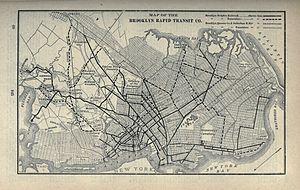Brooklyn Rapid Transit Company
| Brooklyn Rapid Transit Company | |
|---|---|
standard gauge | |
| Minimum radius | ? |
The Brooklyn Rapid Transit Company (BRT) was a
It operated both passenger and freight services on its rail rapid transit, elevated and subway network, making it unique among the three companies which built and operated subway lines in New York City. It became insolvent in 1919. It was restructured and released from bankruptcy as the Brooklyn–Manhattan Transit Corporation in 1923.
Consolidation
The BRT was incorporated January 18, 1896,
The BRT took over the property of a number of surface railroads, the earliest of which, the Brooklyn, Bath and Coney Island Railroad or
Initially the surface and elevated railroad lines ran on steam power. Between 1893 and 1900 the lines were converted to electricity operation. An exception was the service on the Brooklyn Bridge. Trains were operated by cables from 1883 to 1896, when they were converted to electric power[4]

By 1900, it had acquired virtually all of the
- Sea Beach Railway, acquired in November 1897[5]
- Sea View Railroad (Coney Island Elevated), acquired in November 1897[5]
- Brooklyn, Bath and West End Railroad, Coney Island and Gravesend Railway, and South Brooklyn Railway), acquired in November 1898[6] and leased to the BHRR in April 1899[7]
- Brooklyn Elevated Railroad, acquired in March 1899[8] and leased to the BHRR in April 1899[7]
- Brooklyn and Brighton Beach Railroad (Brighton Beach Line), acquired in March 1899[9]
- Prospect Park and Coney Island Railroad (Culver Line), leased to the BHRR on June 18, 1899[13]
Only the
Expansion
BRT opened its first short subway segment, consisting only of an underground terminal at the foot of the
In 1913, the BRT, through another subsidiary, the
During the beginning of the BRT's existence, the LIRR was a competitor of the BRT for passengers in Brooklyn and Queens. Despite competing with nearby lines, the BRT and its predecessors also hosted LIRR passenger trains via track sharing agreements and interchanged freight with them. LIRR Passenger service to the BRT's Brooklyn Bridge terminal began after an agreement in 1895, utilizing BRT elevated lines. LIRR passenger service to downtown Manhattan via the BRT subway and Williamsburg Bridge began with the opening of the Chambers Street Station.[22] Both LIRR and BRT motorman were represented by the same union. Today, BRT successor MTA New York City Transit still receives freight deliveries from LIRR freight successor the New York & Atlantic Railroad in Sunset Park and at Linden Yard.
Demise and legacy
World War I and the attendant massive inflation associated with the war put New York transit operators in a tough position, since their contracts with the City required a five-cent fare be charged, while inflation made the real value of the fare less than three cents in constant currency value. On November 1, 1918, the Malbone Street wreck, the second worst rapid transit train wreck to occur in the United States, occurred on the BRT's Franklin Avenue/Brighton Beach line, killing at least 93 people.[23][24] This further destabilized the financially struggling company, and the BRT filed bankruptcy on December 31, 1918.[25] In 1923 the BRT was restructured and released from bankruptcy as the Brooklyn–Manhattan Transit Corporation (BMT).
Some of the former elevated system of the BRT, dating to 1885, remains in use today. The largest section is the part of today's
Several BRT-era equipment have been preserved. This includes nine BU cars and five AB Standard cars, all which were also operated by the BMT upon the company's creation in 1923.
See also
- Brooklyn–Manhattan Transit Corporation (BMT)
- Interborough Rapid Transit Company (IRT)
- Independent Subway System (ISS)
References
- Brooklyn Daily Eagle. Brooklyn, NY. January 18, 1896. p. 1.
- Brooklyn Daily Eagle. Brooklyn, NY. February 9, 1896. p. 23.
- Brooklyn Daily Eagle. Brooklyn, NY. August 26, 1898. p. 7.
- ^ "Early Rapid Transit in Brooklyn, 1818 to 1900", nyc subways.com
- ^ Brooklyn Daily Eagle. Brooklyn, NY. November 14, 1897. p. 31.
- Brooklyn Daily Eagle. Brooklyn, NY. November 6, 1898. p. 30.
- ^ Brooklyn Daily Eagle. Brooklyn, NY. April 4, 1899. p. 1.
- Brooklyn Daily Eagle. Brooklyn, NY. March 19, 1899. p. 35.
- Brooklyn Daily Eagle. Brooklyn, NY. March 21, 1899. p. 1.
- Brooklyn Daily Eagle. Brooklyn, NY. April 16, 1899. p. 57.
- ^ a b 1914 Moody's Manual: Brooklyn Rapid Transit Company Archived September 27, 2007, at the Wayback Machine
- Brooklyn Daily Eagle. Brooklyn, NY. May 24, 1900. p. 1.
- Brooklyn Daily Eagle. Brooklyn, NY. June 17, 1899. p. 1.
- ISSN 0362-4331. Retrieved January 26, 2020.
- ISSN 0362-4331. Retrieved August 1, 2019.
- ISSN 0362-4331. Retrieved January 11, 2018.
- ^ "Steinway Tunnel Tested By Shonts; After Inspection with Engineers He Says Tracks Are the Best He Has Ever Tried. Party Rides Through Tube Interborough's Chief and Other Officials Are Hoisted from a Subway Shaft in a Dirt Bucket" (PDF). The New York Times. June 16, 1915. Retrieved May 4, 2017.
- ^ "Broadway Subway Opened To Coney By Special Train. Brooklynites Try New Manhattan Link From Canal St. to Union Square. Go Via Fourth Ave. Tube". The Brooklyn Daily Eagle. September 4, 1917. Retrieved May 31, 2019.
- ISSN 0362-4331. Retrieved November 5, 2016.
- ^ "Subway Tunnel Through". The New York Times. August 8, 1919. Retrieved February 28, 2010.
- ^ "Celebrate Opening of Subway Link". The New York Times. July 1, 1924. Retrieved February 13, 2010.
- ISBN 978-1-60702-864-2.
- ISSN 0362-4331. Retrieved November 3, 2019.
- .
- ISBN 0-671-67756-X.


